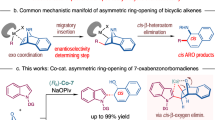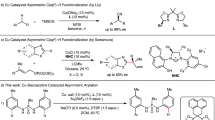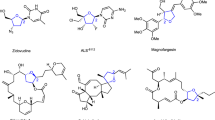Abstract
Though Cp*Rh(iii) complexes are prominent and versatile catalysts for C–H bond functionalization reactions, catalytic stereocontrol is difficult due to the lack of vacant coordination sites. Here, we report a hybrid strategy for inducing chirality without using previously reported chiral Cpx ligands. A preformed hybrid catalyst, [Cp*RhLN][6,6′-Br-(S)-BINSate], catalysed C–H activation and subsequent conjugate addition of 2-phenylpyridine derivatives to enones in good yield and enantioselectivity (enantiomeric ratio up to 95:5). In addition to 2-phenylpyridines, the conjugate addition of 6-arylpurines proceeded with an enantiomeric ratio of up to 91:9 using [Cp*RhLN][(R)-SPISate]. The results demonstrate that a chiral organic anion can efficiently control the enantioselectivity of Cp*Rh(iii)-catalysed C–H bond functionalization without a chiral Cpx ligand.
This is a preview of subscription content, access via your institution
Access options
Access Nature and 54 other Nature Portfolio journals
Get Nature+, our best-value online-access subscription
$29.99 / 30 days
cancel any time
Subscribe to this journal
Receive 12 digital issues and online access to articles
$119.00 per year
only $9.92 per issue
Buy this article
- Purchase on Springer Link
- Instant access to full article PDF
Prices may be subject to local taxes which are calculated during checkout



Similar content being viewed by others
Change history
03 January 2019
In the version of this Article originally published, four important papers for transition metal/chiral anion asymmetric catalysis and 1,1'-binaphthyl-2,2'-disulfonate (BINSate) were erroneously omitted. These have now been added into the reference list at numbers 33, 43, 57 and 58, and the list renumbered accordingly:
References
Trost, B. M. The atom economy—a search for synthetic efficiency. Science 254, 1471–1477 (1991).
Wender, P. A. & Miller, B. L. Synthesis at the molecular frontier. Nature 460, 197–201 (2009).
Satoh, T. & Miura, M. Oxidative coupling of aromatic substrates with alkynes and alkenes under rhodium catalysis. Chem. Eur. J. 16, 11212–11222 (2010).
McMurray, L., O’Hara, F. & Gaunt, M. J. Recent developments in natural product synthesis using metal-catalysed C–H bond functionalisation. Chem. Soc. Rev. 40, 1885–1898 (2011).
Song, G., Wang, F. & Li, X. C–C, C–O and C–N bond formation via rhodium(III)-catalyzed oxidative C–H activation. Chem. Soc. Rev. 41, 3651–3678 (2012).
Kuhl, N., Schröder, N. & Glorius, F. Formal SN-type reactions in rhodium(III)-catalyzed C–H bond activation. Adv. Synth. Catal. 356, 1443–1460 (2014).
Song, G. & Li, X. Substrate activation strategies in rhodium(III)-catalyzed selective functionalization of arenes. Acc. Chem. Res. 48, 1007–1020 (2015).
Ye, B. & Cramer, N. Chiral cyclopentadienyls: enabling ligands for asymmetric Rh(III)-catalyzed C–H functionalizations. Acc. Chem. Res. 48, 1308–1318 (2015).
Moselage, M., Li, J. & Ackermann, L. Cobalt-catalyzed C–H activation. ACS Catal. 6, 498–525 (2016).
Gensch, T., Hopkinson, M. N., Glorius, F. & Wencel-Delord, J. Mild metal-catalyzed C–H activation: examples and concepts. Chem. Soc. Rev. 45, 2900–2936 (2016).
Yoshino, T. & Matsunaga, S. (Pentamethylcyclopentadienyl)cobalt(III)-catalyzed C–H bond functionalization: from discovery to unique reactivity and selectivity. Adv. Synth. Catal. 359, 1245–1262 (2017).
Wang, S., Chen, S.-Y. & Yu, X.-Q. C–H functionalization by high-valent Cp*Co(III) catalysis. Chem. Commun. 53, 3165–3180 (2017).
He, J., Wasa, M., Chan, K. S. L., Shao, Q. & Yu, J.-Q. Palladium-catalyzed transformations of alkyl C–H bonds. Chem. Rev. 117, 8754–8786 (2017).
Newton, C. G., Wang, S.-G., Oliveira, C. C. & Cramer, N. Catalytic enantioselective transformations involving C–H bond cleavage by transition-metal complexes. Chem. Rev. 117, 8908–8976 (2017).
Hummel, J. R., Boerth, J. A. & Ellman, J. A. Transition-metal-catalyzed C–H bond addition to carbonyls, imines, and related polarized π bonds. Chem. Rev. 117, 9163–9227 (2017).
Dong, Z., Ren, Z., Thompson, S. J., Xu, Y. & Dong, G. Transition-metal-catalyzed C–H alkylation using alkenes. Chem. Rev. 117, 9333–9403 (2017).
Ueura, K., Satoh, T. & Miura, M. Rhodium- and iridium-catalyzed oxidative coupling of benzoic acids with alkynes via regioselective C−H bond cleavage. J. Org. Chem. 72, 5362–5367 (2007).
Kang, T., Kim, Y., Lee, D., Wang, Z. & Chang, S. Iridium-catalyzed intermolecular amidation of sp3 C–H bonds: late-stage functionalization of an unactivated methyl group. J. Am. Chem. Soc. 136, 4141–4144 (2014).
Gwon, D., Park, S. & Chang, S. Dual role of carboxylic acid additive: mechanistic studies and implication for the asymmetric C–H amidation. Tetrahedron 71, 4504–4511 (2015).
Newton, C. G., Kossler, D. & Cramer, N. Asymmetric catalysis powered by chiral cyclopentadienyl ligands. J. Am. Chem. Soc. 138, 3935–3941 (2016).
Ye, B. & Cramer, N. Chiral cyclopentadienyl ligands as stereocontrolling element in asymmetric C–H functionalization. Science 338, 504–506 (2012).
Ye, B. & Cramer, N. A tunable class of chiral Cp ligands for enantioselective rhodium(III)-catalyzed C–H allylations of benzamides. J. Am. Chem. Soc. 135, 636–639 (2013).
Sun, Y. & Cramer, N. Rhodium(III)-catalyzed enantiotopic C−H activation enables access to P-chiral cyclic phosphinamides. Angew. Chem. Int. Ed. 56, 364–367 (2017).
Jang, Y. S., Dieckmann, M. & Cramer, N. Cooperative effects between chiral Cpx-iridium(III) catalysts and chiral carboxylic acids in enantioselective C−H amidations of phosphine oxides. Angew. Chem. Int. Ed. 56, 15088–15092 (2017).
Zheng, J., Cui, W.-J., Zheng, C. & You, S.-L. Synthesis and application of chiral spiro Cp ligands in rhodium-catalyzed asymmetric oxidative coupling of biaryl compounds with alkenes. J. Am. Chem. Soc. 138, 5242–5245 (2016).
Zheng, J., Wang, S.-B., Zheng, C. & You, S.-L. Asymmetric synthesis of spiropyrazolones by rhodium-catalyzed C(sp2)−H functionalization/annulation reactions. Angew. Chem. Int. Ed. 56, 4540–4544 (2017).
Jia, Z.-J. et al. General enantioselective C−H activation with efficiently tunable cyclopentadienyl ligands. Angew. Chem. Int. Ed. 56, 2429–2434 (2017).
Hyster, T. K., Knörr, L., Ward, T. R. & Rovis, T. Biotinylated Rh(III) complexes in engineered streptavidin for accelerated asymmetric C–H activation. Science 338, 500–503 (2012).
Kossler, D. & Cramer, N. Neutral chiral cyclopentadienyl Ru(II)Cl catalysts enable enantioselective [2+2]-cycloadditions. Chem. Sci. 8, 1862–1866 (2017).
Wang, S.-G., Park, S. H. & Cramer, N. A readily accessible class of chiral Cp ligands and their application in RuII-catalyzed enantioselective syntheses of dihydrobenzoindoles. Angew. Chem. Int. Ed. 57, 5459–5462 (2018).
Shao, Z. & Zhang, H. Combining transition metal catalysis and organocatalysis: a broad new concept for catalysis. Chem. Soc. Rev. 38, 2745–2755 (2009).
Phipps, R. J., Hamilton, G. L. & Toste, F. D. The progression of chiral anions from concepts to applications in asymmetric catalysis. Nat. Chem. 4, 603–614 (2012).
Mahlau, M. & List, B. Asymmetric counteranion‐directed catalysis: Concept, definition, and applications. Angew. Chem. Int. Ed. 52, 518–533 (2013).
Du, Z. & Shao, Z. Combining transition metal catalysis and organocatalysis—an update. Chem. Soc. Rev. 42, 1337–1378 (2013).
Inamdar, S. M., Shinde, V. S. & Patil, N. T. Enantioselective cooperative catalysis. Org. Biomol. Chem. 13, 8116–8162 (2015).
Qin, Y., Zhu, L. & Luo, S. Organocatalysis in inert C–H bond functionalization. Chem. Rev. 117, 9433–9520 (2017).
Smalley, A. P., Cuthbertson, J. D. & Gaunt, M. J. Palladium-catalyzed enantioselective C–H activation of aliphatic amines using chiral anionic binol-phosphoric acid ligands. J. Am. Chem. Soc. 139, 1412–1415 (2017).
Lapointe, D. & Fagnou, K. Overview of the mechanistic work on the concerted metallation–deprotonation pathway. Chem. Lett. 39, 1118–1126 (2010).
Davies, D. L., Macgregor, S. A. & McMullin, C. L. Computational studies of carboxylate-assisted C–H activation and functionalization at group 8–10 transition metal centers. Chem. Rev. 117, 8649–8709 (2017).
Chai, Z. & Rainey, T. J. Pd(II)/Brønsted acid catalyzed enantioselective allylic C–H activation for the synthesis of spirocyclic rings. J. Am. Chem. Soc. 134, 3615–3618 (2012).
Wang, P.-S., Lin, H.-C., Zhai, Y.-J., Han, Z.-Y. & Gong, L.-Z. Chiral counteranion strategy for asymmetric oxidative C(sp3)–H/C(sp3)–H coupling: enantioselective α-allylation of aldehydes with terminal alkenes. Angew. Chem. Int. Ed. 53, 12218–12221 (2014).
Zell, D., Bursch, M., Müller, V., Grimme, S. & Ackermann, L. Full selectivity control in cobalt(III)‐catalyzed C−H alkylations by switching of the C−H activation mechanism. Angew. Chem. Int. Ed. 56, 10378–10382 (2017).
Pan, S.C. & List, B. The catalytic acylcyanation of imines. Chem. Asian J. 3, 430–437 (2008).
Hatano, M., Maki, T., Moriyama, K., Arinobe, M. & Ishihara, K. Pyridinium 1,1’-binaphthyl-2,2’-disulfonates as highly effective chiral Brønsted acid–base combined salt catalysts for enantioselective Mannich-type reaction. J. Am. Chem. Soc. 130, 16858–16860 (2008).
Hatano, M. & Ishihara, K. Chiral 1,1′-binaphthyl-2,2′-disulfonic acid (BINSA) and its derivatives for asymmetric catalysis. Asian J. Org. Chem. 3, 352–365 (2014).
Jerphagnon, T., Pizzuti, M. G., Minnaard, A. J. & Feringa, B. L. Recent advances in enantioselective copper-catalyzed 1,4-addition. Chem. Soc. Rev. 38, 1039–1075 (2009).
Edwards, H. J., Hargrave, J. D., Penrose, S. D. & Frost, C. G. Synthetic applications of rhodium catalysed conjugate addition. Chem. Soc. Rev. 39, 2093–2105 (2010).
Yang, L., Correia, C. A. & Li, C.-J. Rhodium-catalyzed C–H activation and conjugate addition under mild conditions. Org. Biomol. Chem. 9, 7176–7179 (2011).
Yang, L., Qian, B. & Huang, H. Brønsted acid enhanced rhodium-catalyzed conjugate addition of aryl C–H bonds to α,β-unsaturated ketones under mild conditions. Chem. Eur. J. 18, 9511–9515 (2012).
Potter, T. J., Kamber, D. N., Mercado, B. Q. & Ellman, J. A. Rh(III)-catalyzed aryl and alkenyl C–H bond addition to diverse nitroalkenes. ACS Catal. 7, 150–153 (2017).
Yoshino, T., Ikemoto, H., Matsunaga, S. & Kanai, M. A cationic high-valent Cp*CoIII complex for the catalytic generation of nucleophilic organometallic species: directed C–H bond activation. Angew. Chem. Int. Ed. 52, 2207–2211 (2013).
Li, J. et al. Mild cobalt(III)-catalyzed C–H hydroarylation of conjugated C=C/C=O bonds. Adv. Synth. Catal. 359, 1717–1724 (2017).
Zhang, Z., Han, S., Tang, M., Ackermann, L. & Li, J. C–H alkylations of (hetero)arenes by maleimides and maleate esters through cobalt(III) catalysis. Org. Lett. 19, 3315–3318 (2017).
Kim, H. J. et al. Hydrogen-bond-assisted controlled C–H functionalization via adaptive recognition of a purine directing group. J. Am. Chem. Soc. 136, 1132–1140 (2014).
Kurihara T. et al. Synthesis of 1,1′-spirobiindane-7,7′-disulfonic acid and disulfonimide: application for catalytic asymmetric aminalization. Chem. Asian J. https://doi.org/10.1002/asia.201800341 (2018).
Hamilton, G. L., Kang, E. J., Mba, M. & Toste, F. D. A powerful chiral counterion strategy for asymmetric transition metal catalysis. Science 317, 496–499 (2007).
Mukherjee, S. & List, B. Chiral counteranions in asymmetric transition-metal catalysis: Highly enantioselective Pd/Brønsted acid-catalyzed direct α-allylation of aldehydes. J. Am. Chem. Soc. 129, 11336–11337 (2007).
Mayer, S. & List, B. Asymmetric counteranion-directed catalysis. Angew. Chem. Int. Ed. 45, 4193–4195 (2006).
Acknowledgements
This work was supported in part by JST ACT-C grant number JPMJCR12Z6, Japan, JSPS KAKENHI grant numbers JP15H05802 and JP15H05810 in Precisely Designed Catalysts with Customized Scaffolding, JSPS KAKENHI grant number JP18H04637 in Hybrid Catalysis, JSPS KAKENHI grant number JP17K15417, and The Asahi Glass Foundation and Astellas Foundation (to S.M.). We thank J. Hasegawa at Hokkaido University for fruitful discussion on the reaction mechanism.
Author information
Authors and Affiliations
Contributions
S.S., T.K., K.N., T.M. and T.Y. performed the experiments and analysed the data. S.S., M.H., K.I., T.Y. and S.M. conceived and designed the experiments and prepared the manuscript. All authors contributed to discussions and commented on the manuscript.
Corresponding authors
Ethics declarations
Competing interests
The authors declare no competing interests.
Additional information
Publisher’s note: Springer Nature remains neutral with regard to jurisdictional claims in published maps and institutional affiliations.
Supplementary Information
Supplementary Information
Supplementary Methods, Supplementary Figures 1–64, Supplementary References
Rights and permissions
About this article
Cite this article
Satake, S., Kurihara, T., Nishikawa, K. et al. Pentamethylcyclopentadienyl rhodium(III)–chiral disulfonate hybrid catalysis for enantioselective C–H bond functionalization. Nat Catal 1, 585–591 (2018). https://doi.org/10.1038/s41929-018-0106-5
Received:
Accepted:
Published:
Issue Date:
DOI: https://doi.org/10.1038/s41929-018-0106-5
This article is cited by
-
Enantioselective transition-metal catalysis via an anion-binding approach
Nature (2023)
-
Single-atom Rh/N-doped carbon electrocatalyst for formic acid oxidation
Nature Nanotechnology (2020)
-
α-Branched amines by catalytic 1,1-addition of C–H bonds and aminating agents to terminal alkenes
Nature Catalysis (2019)



